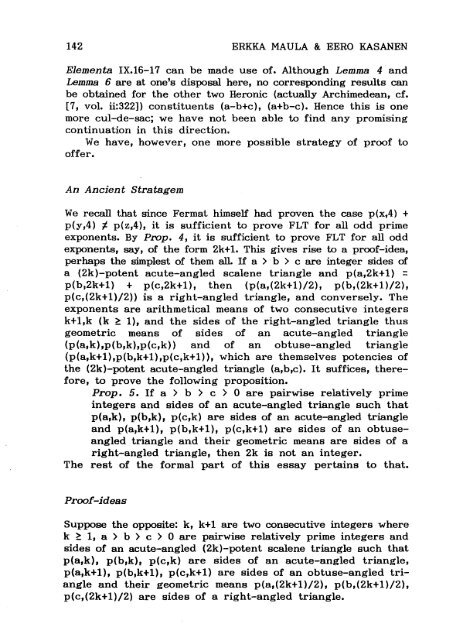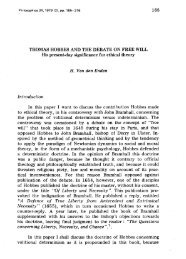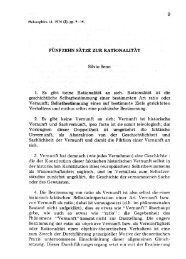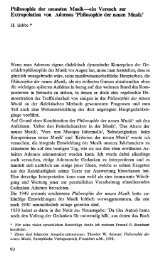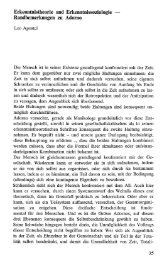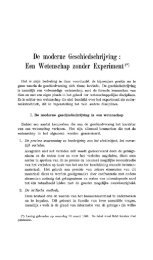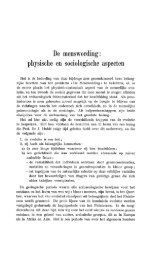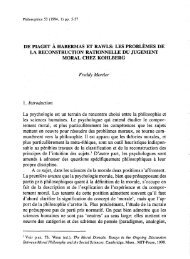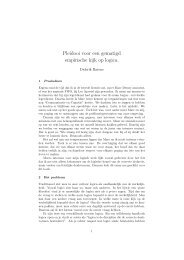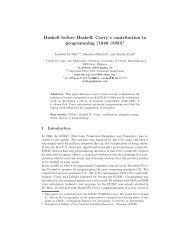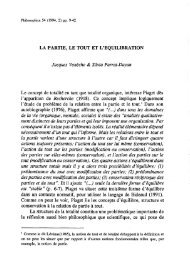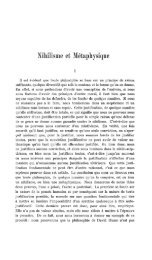CHEZ FERMAT A.D. 1637' Erkka Maula and Eero Kasanen Abstract ...
CHEZ FERMAT A.D. 1637' Erkka Maula and Eero Kasanen Abstract ...
CHEZ FERMAT A.D. 1637' Erkka Maula and Eero Kasanen Abstract ...
Create successful ePaper yourself
Turn your PDF publications into a flip-book with our unique Google optimized e-Paper software.
142 ERKKA MAULA & EERO KASANEN<br />
Elementa IX.16-17 can be made use of. Although LemmB 4 <strong>and</strong><br />
LemmB 6 are at one's disposal here, no corresponding results can<br />
be obtained for the other two Heronic (actually Archimedean, cf.<br />
[7, vol. ü:322]) constituents (a-b+c), (a+b-c). Hence this is one<br />
more cul-de-sac; we have not been able to find any promising<br />
continuation in this direction.<br />
We have, however, one more possible strategy of praof ta<br />
offer.<br />
An Ancient StrBtagem<br />
We recall that aince Fermat himself had proven the case p(x,4) +<br />
p(y,4) 1- p(z,4), it is sufficient to prove FLT for ail odd prime<br />
exponents. By Prop. 4, it is sufficient to prove FLT for ail odd<br />
exponents, say, of the form 2k+ 1. This gives rise ta a proof-idea,<br />
perhaps the simplest of them all. If a > b > c are integer sides of<br />
a (2k)-potent acute-angled scalene triangle <strong>and</strong> p(a,2k+l) =<br />
p(b,2k+l) + p(c,2k+l), then (p(a,(2k+l)/2), p(b,(2k+l)/2),<br />
p(c,(2k+l)/2» is a right-angled triangle, <strong>and</strong> conversely. The<br />
exponents are arithmetical means of two consecutive integers<br />
k+l,k (k ~ 1), <strong>and</strong> the sides of the right-angled triangle thus<br />
geometric means of sides of an acute-angled triangle<br />
(p(a,k),p(b,k),p(c,k» <strong>and</strong> of an obtuse-angled triangle<br />
(p(a,k+l),p(b,k+l),p(c,k+l», which are themselves potencies of<br />
the (2k)-potent acute-angled triangle (a,b,c). It suffices, therefore,<br />
ta prove the following proposition.<br />
Prop. 5. If a > b > c > 0 are pairwise relatively prime<br />
integers <strong>and</strong> sides of an acute-angled triangle such that<br />
p(a,k), p(b,k), p(c,k) are sides of an acute-angled triangle<br />
<strong>and</strong> p(a,k+l), p(b,k+1), p(c,k+1) are sides of an obtuseangled<br />
triangle <strong>and</strong> their geometric means are sides of a<br />
right-angled triangle, then 2k is not an integer.<br />
The rest of the formaI part of this essay pertains to that.<br />
Proof-ideBS<br />
Suppose the opposite: k, k+ 1 are two consecutive integers where<br />
k ~<br />
1, a > b > c > 0 are pair wise relatively prime integers <strong>and</strong><br />
sides of an acute-angled (2k)-potent scalene triangle such that<br />
p(a,k), p(b,k), p(c,k) are sides of an acute-angled triangle,<br />
p(a,k+1), p(b,k+1), p(c,k+1} are sides of an obtuse-angled triangle<br />
<strong>and</strong> their geometric means p(a,(2k+1)/2), p(b,(2k+1)/2),<br />
p(c,(2k+1)/2) are sides of a right-angled triangle.


